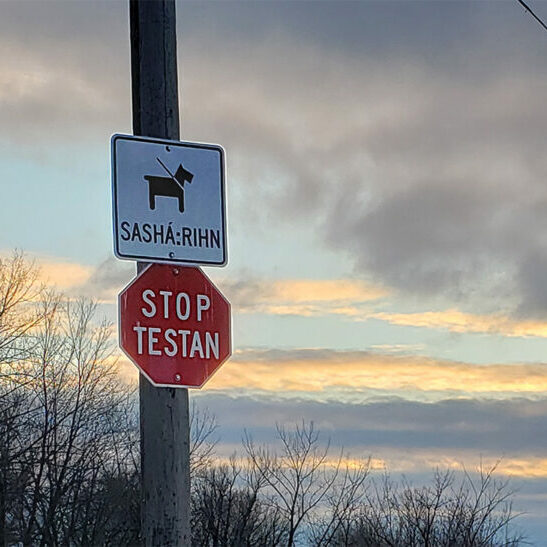
You live in Anmoughcawgen
Above image: Bilingual signs at Kahnawake in the First Nations Reserve, Quebec, Canada. (Photo: Sage Carbone)
By Sage Carbone, 2023
Nickelodeon hosted a program called “Kids Choose the President” in 1996 to encourage civic engagement and teach children about the value of choice. “I just spoke to Bill Clinton and he thanked me for my vote!” I exclaimed proudly, running through my grandparents’ house and knotting the long cord hanging from the phone. It was just a recording, but it felt different from waving at, or shaking hands with, the local politicians who walked along the route of our hometown’s Memorial Day parade.
I chased that feeling for decades, wanting to untangle my pursuits in the same way I wove those small fingers through the coils of that phone cord, yellowed by years of tobacco smoke. The narrative that Native Americans exist only on reservations with artifacts in museum collections attempts to minimize our impact in urban society. I have experienced firsthand how the erasure of Indigenous voices leads to unequal representation in diversity training, community programming, Bipoc initiatives, etc.
This is why I proposed the Indigenous Languages Visibility Project – part of the city’s Participatory Budgeting cycle awarded in late 2021 with voter participation.
As one of seven winning projects, the city will use $180,000 on an African American & Indigenous Peoples Historical Reckoning Project to recognize the historical sites of Indigenous peoples in Cambridge and include traditional Eastern Woodland languages on city property, as well as to restore and expand the African American Heritage Trail in Cambridge to highlight the accomplishments of Black Cantabrigians.
Since the announcement I have worked with local Indigenous scholars and members of the Massachusett Tribe at Ponkapoag, along with individuals in the City Manager’s Office, History Cambridge and the City Council to support the Historical Commission in efforts to Indigenize these spaces.
I was inspired by a visit to the Schemitzun Feast of Green Corn and Dance at the Mashantucket Pequot Indian Reservation, one of the oldest celebrations on Turtle Island (North America) where we can give thanks to the Creator for our ancestors and our harvests. While waiting for the bus back to the parking area, I noticed that the “Stop” sign was in English and Mohegan-Pequot.
This small but poignant example of decolonization became a mission for me; I took on the responsibility to bring it back to the city I’ve lived in for nearly a decade.
For millennia before this area became known as Newtowne and then Cambridge, it was called Anmoughcawgen. In the Algonquin Natick dialect this means “fishing weir” or “beaver dam,” which accurately described the neighborhoods stretching from Alewife to Kendall/MIT. The Charles River was the Quinobequin, or “meandering still water” and what is now Putnam Avenue was referred to as “Wigwam Neck.”
The pronunciation of Anmoughcawgen is unclear. History books divided dialects between north and south New England. Since Maine was part of Massachusetts at the time, I’d suggest using Northern pronunciation guidelines. Per the book “Indian Place Names of New England” (1962): “Polysyllabic names usually stress the second or third syllable, but this rule is not rigid. Names formed of many combined syllables break into several forms, and must be learned by practice.” Anmoughcawgen would therefore be pronounced: An-mou-CAW-gen (in which “gen” rhymes with “hen”).
Residents and visitors can look forward to seeing these translations along with others, as well as updates to current historical markers to include Indigenous perspectives. The purpose of this project is not to erase the nearly 400 years of our city’s history, but to recognize that the history did not begin when it was colonized. My hope is that this funding, along with other civic efforts, will empower the next seven generations to reclaim these spaces. We are still here, and we will continue to prosper.
Sage Brook Carbone lives on Third Street in Cambridge and is a member of the Northern Narragansett Indian Tribe of Rhode Island. She is a descendant of Nipmuc, Massachusett and Mi’kmaq First Nations. This piece is part of a series for History Cambridge made possible through a grant from the Cambridge Community Foundation.
This article was originally published in our “Did You Know?” column in Cambridge Day.
